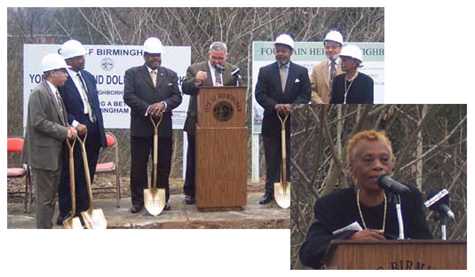


Outspoken Advocate Doris Powell is a wiry woman, in her 60s, with a voice that crackles with energy and determination. She has tackled everything from litter to drug dealers to city officials as a neighborhood leader, and public transit and downtown development as a civic leader since moving back to Birmingham in 1998 from the Northeast where was director of sales and community outreach for two Atlantic City hotels and a casino. Her activism started on the day of her father’s funeral. While her family was mourning his loss inside his Fountain Heights home, someone broke into the garage. She and about 25 other homeowners on 17th Street North mobilized to look out for each other and clean up the neighborhood. They confronted drug dealing at the infamous “Four Way,” the intersection of 15th Avenue North and 17th Street where the open-air market was so brazen that city police set up a mobile anti-crime unit.
After campaigning on a platform to bring the Fountain Heights Neighborhood Improvement Plan to life, Powell won the neighborhood presidency in 2002 after failing in 2000. The City of Birmingham’s Community Development Department and the Housing Authority of the Birmingham District (HABD) worked to find appropriate sites in Fountain Heights to build 25 affordable homes. At the ground-breaking ceremony for the first four houses earlier this year, Jim Fenstermaker, head of Community Development, credited the work of Powell’s predecessors, but he also praised her. “(She) is a strong advocate for the Fountain Heights Neighborhood, a very hard worker. No one will ever outwork Doris Powell. She has more energy than I will ever have, and she’s a large part of the reason we’re here today.” But residents balked at HABD’s initial plans for the four houses. Rather than build houses extending down a slope towards an alley, the plan left a small park space behind the houses. Residents nixed the idea, saying the park could attract criminal or mischievous activity. HABD redrew the plans. “If my car is in the shop, my sister can drop me off at City Hall and I can walk home in 10 minutes. And I’ve done it in 90 degree heat” she says. “But then you have persons 70, sometimes 80 years old, and they don’t have the capacity to do that. You’re crippling your community.” Poorest, richest in one area But it also encompasses half of Birmingham’s Central Business District, including the headquarters of the police department, the phone company and the power company. It now includes headquarters of the FBI and other agencies, and will include the new regional offices of the Social Security Administration. It also includes two of Downtown’s biggest residential loft developments, Jemison Flats and Phoenix Lofts. Soon it will include even bigger ones, such as condominiums planned for the Pizitz department store, the Jefferson Home Furniture, and the Cabana Hotel buildings. When the incumbent ran in 2004 for the neighborhood presidency, Powell campaigned for votes of loft residents as well as those in her residential base north of I-20/59. Her Central City counterpart, Louise Shufford, did not reach out to loft residents. Shufford’s traditional residential base was gone, displaced when HABD razed Metropolitan Gardens, the public housing community where Ms. Shufford was also tenant council president, to build its first Hope VI project, now called Park Place. Most of Central City’s residential base is now in its loft districts, which run east from 19th Street North to the Red Mountain Expressway and south from Third Avenue North to Morris Avenue. That’s where the new president, 34-year-old Jay Taylor lives. Shufford, in her 70s, maintains that “someone put him up” to running against her last year, when he brought in his paperwork to run “just minutes” before qualifying ended. Taylor says nothing could be further from the truth. When he signed up to run, hours before qualifying ended, no other names were on the list, he says. Nor did anyone encourage him to run against Shufford. Rather, Taylor wanted representation for the loft constituency, who felt their concerns were largely ignored by neighborhood officials. |
|
SUBSCRIBE l ABOUT US l FEATURES l PERSPECTIVES l LATEST VIEWS l COMMUNITY CHEST Website
Development: Deidre Ali Creative
Services, LLC |

